Help guide for the Regional Innovation Ecosystems (RIE) expression of interest form
This help guide is a companion for the Prairies Economic Development Canada (PrairiesCan) Regional Innovation Ecosystems program.
Preparation
Before beginning your expression of interest (EOI), carefully review the guidelines for this program, to ensure your organization is eligible to apply for funding and your proposed activities meet the program’s objectives and criteria.
- Delivered by Canada’s regional development agencies (RDAs), in this case PrairiesCan, this expression of interest will be used to determine whether you will be invited to submit a full Regional Innovation Ecosystems (RIE) application.
- Fields marked with an asterisk (*) are mandatory and you will be unable to submit your EOI if such fields are left incomplete.
- Incomplete EOIs cannot be assessed and may be deemed ineligible.
- Contact PrairiesCan should you have any questions or wish to discuss your proposed project or other relevant government programs that may be applicable to your project.
Completing the form
Refer to the guidance below for explanations of how to complete the expression of interest form.
Organization information
- Legal name of applicant organization *
- The legal name as shown on the certificate of incorporation or registration.
- Operating name (if different than legal name)
- Provide the name you are operating under if different from the full legal name.
- Mailing address (Including suite, unit, apt #)
- The mailing address of the applicant organization.
- Email address
- Include the general email address of your organization.
- Website
- Your organization’s website address (if available).
- Corporate Status *
- Indicate if your organization is a for-profit or not-for-profit.
- Organization Type (select best fit) *
- Select from the drop down menu what most accurately reflects your organization type.
- Provide your Canada Revenue Agency (CRA) Business number or Goods and Services Tax (GST) number (first 9 digits only)
- The unique business number or GST number assigned to the applicant organization by the CRA. A business number or GST number must be obtained through the CRA. For information on obtaining a business number visit the CRA’s Business Number Registration page.
- Jurisdiction of Incorporation *
- Select from the drop down menu your organization’s jurisdiction of incorporation.
- Incorporation Number
- As shown on your Certification of Incorporation.
- In the province of
- Indicate in which province the organization was incorporated.
- Date of incorporation
- Indicate the date the organization was incorporated.
- Alternative number type
- Please enter if you do not have a CRA Business Number or Incorporation Number, so your organization can be identified (e.g. band number, education number).
- Number of employees working for your organization (full time equivalents)
- Indicate the number of Full-Time Equivalent employees (FTEs) working for your organization (and if applicable, any affiliated companies). Part-time employees should be calculated based on their equivalent to a FTE (i.e., 1 part time employee working approx. 20 hrs/week should be represented as 0.5 FTE).
- Provide a brief summary of your organization and mandate (Maximum of 500 characters)
- The description of the applicant organization and an explanation of the organization’s mandate and priorities.
Include the date your organization established business in Canada.
Project primary contact
This person will be contacted for any follow-up on this application.
- Title *
- Provide the contact person’s job title (e.g., President, Executive Director).
- Email address *
- The email at which the primary contact may be reached.
Project secondary contact
- Title
- Provide the contact person’s job title (e.g., President, Executive Director).
- Email address
- The email at which the secondary contact may be reached.
Project information
- Project title (maximum of 90 characters) *
- Provide a project title that accurately reflects the activities and results of the project. Should your project be approved, this description will be disclosed on the Open Government Portal website as part of its proactive disclosure guidelines. A project title can be a maximum of 90 characters including spaces.
- Project address is the same as Mailing address on the account?
- Yes / No
Select “Yes” if the address at which the project will be undertaken is the same as the organization’s mailing address. If checked, the mailing address will be automatically entered. - Project address / location (Including suite, unit, apt #): *
- If the project address is different from the mailing address, enter the location at which the project will take place.
- Describe your project activities in plain language. The description should include the objectives of the project, as well as, key activities of the project and how these activities will achieve the intended objectives of the project. (Maximum of 1,000 characters including spaces) *
- Briefly describe your project in plain language. This is important as this section will be used in summary documents to describe your project at various review stages. The description should provide the department with a high-level overview of the project and outline the main elements of the project. It should provide an understanding of why you are seeking financial assistance, how you will use the funds, and how the funds will support the objectives of your project. Do not use technical language in this section.
Eligible projects aim to create, grow and nurture inclusive regional ecosystems that support business needs throughout the innovation continuum, and foster an entrepreneurial environment conducive to innovation, growth and competitiveness. Objectives of RIE are to:- grow strategic clusters;
- enhance the development and reach of business accelerators and incubators;
- promote business productivity and global competitiveness; and
- enhance the capacity to support underrepresented groups.
- Briefly describe the economic benefits associated with this project. (1,000 characters including spaces) *
- Provide numerical values measured year over year from the project funding start date typically to 1 year following the project completion date.
Provide an explanation as to how these economic outcomes will be achieved. Ensure to identify and detail all assumptions to support the reasonableness of your economic outcomes. All projects will be screened for significance of outcomes and the likelihood of them being achieved.
If your project supports the Government of Canada’s commitment to inclusive growth (under-represented groups) you may include this in your explanation. Note: recipients will be encouraged to track inclusiveness indicators (i.e., women, Indigenous Peoples, and youth).
Describe the economic benefits associated with the proposed project including sales and job creation (e.g. number of highly qualified personnel). - Which regional development agency (RDA) Priority does this project best support?
Choose 1 priority that best aligns with your project’s objectives, activities, and outcomes. Your project may be compared to similar projects of a chosen priority area.
Priority definitions are as follows:
Advanced manufacturing – This is defined by developing and adopting innovative technologies to:
- create new products;
- enhance processes ;
- establish more efficient and cost-effective ways of working.
Clean resources – This refers to transitioning from the old resource economy into a new resource economy. It is where innovation drives economic and environmental competitiveness in the energy, mining and forestry sectors. It leverages Canada's natural resources advantage to transition to a low-carbon economy.
Clean technology – This refers to any process, product or service that reduces environmental harm in order to:
- control costs;
- meet new regulations;
- improve global competitiveness;
- reduce harm to climate, water, land and air.
Digital industries – This includes:
- information and communication technology (ICT);
- digital and interactive media;
- content industries.
Health/bio-sciences – This includes a wide range of companies, such as:
- pharmaceutical developers and makers;
- medical devices and biomedical innovators;
- digital health solutions producers;
- precision health.
- disruptive technologies, such as:
- artificial intelligence (AI);
- big data analytics;
- 3-D printing;
- Robotics;
- Nanotechnologies.
Natural resources value-added processing – This includes processing natural resources in the energy, mineral or forestry sectors. This adds value to the raw materials.
Value-added agriculture – This is a complex and interdependent sector that includes agriculture, fisheries and aquaculture. It also includes food and beverages processing
To select 1 of the RDA’s priorities, click on the magnifying glass icon and the “Lookup records” window will appear where you can then select a priority.

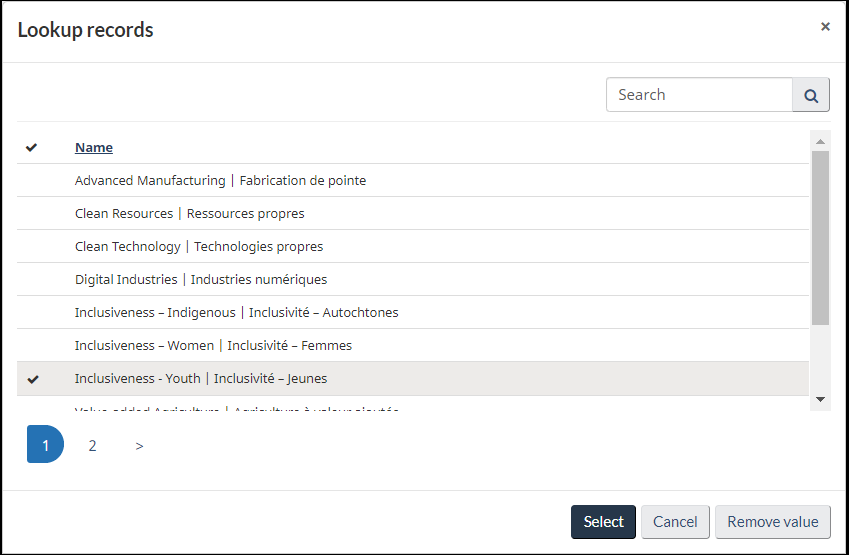
- Explain how this project supports the indicated priority. (Maximum of 2,000 characters).
- Explain in detail how the project’s objectives, activities, and outcomes align with the selected RDA priority.
Indicate whether your project addresses one of PrairiesCan’s additional areas of focus (i.e. Critical Minerals Processing; Food and Ingredients Processing; Zero Emission Heavy Equipment Vehicles) and whether your project aligns with other PrairiesCan’s key priorities where applicable.
Project timelines
- Proposed project start date *
- This is the proposed date the agreement between the Recipient and PrairiesCan comes into effect. The date entered in this field should be in the future. Any costs incurred prior to this date are not eligible for reimbursement under the terms of the agreement and are outside of the scope of the project. This can be thought of as the start date for the project.
- Proposed project end date *
- This is the anticipated date the project activity will cease.
Project costs
- Description *
- List the various cost items you anticipate incurring in the implementation of the project. Each cost item should have its own line (see instructions below).
Recipients must ensure all project cost items are clearly verifiable.
Eligible project costs
All proposed costs should be incremental and essential to the implementation of the project. Costs that may be eligible for reimbursement include, but may not be limited to:- cost of labour (e.g. wages and benefits);
- capital costs (e.g. purchase of machinery, equipment);
- operating costs that are directly related to the project like management fees or working capital;
- consultancy fees (e.g. professional, advisory and technical services);
- costs related to intellectual property;
- preproduction (e.g. technological development and commercial demonstrations);
- subcontracting costs;
- production and distribution of promotional material and management tools;
- anticipated cost of maintaining the useful life of an asset for a reasonable period; and
- costs related to specialized services such as, testing services, research and development services, technical or innovation services, sector development strategies in all markets and business networking.
Ineligible project costs
Costs that are deemed unreasonable, not incremental, and/or not directly related to project activities will be ineligible for reimbursement. These include, but may not be limited to:- the refinancing of an existing debt;
- the purchase of any assets for more than the fair market value of the said asset;
- costs of amortization; and
- land acquisition and goodwill.
Project costs incurred by the applicant in the absence of a signed funding agreement with PrairiesCan are incurred at the sole risk of the applicant. - Type *
- Indicate if the cost is capital (e.g. purchase of equipment and associated costs such as installation) or non-capital (e.g. salaries, professional fees).
- Amount *
- The anticipated amount of the cost item.
- Total Project Costs
- Automatically sums the cost items listed above.
Note: This total must equal the Total expenditures from the Cash Flows section below.
To add a project cost item, click on the ![]() button and the following window will appear for you to provide the information. Click the Submit button once complete. You will still have the ability to edit the project cost item after hitting this Submit button.
button and the following window will appear for you to provide the information. Click the Submit button once complete. You will still have the ability to edit the project cost item after hitting this Submit button.
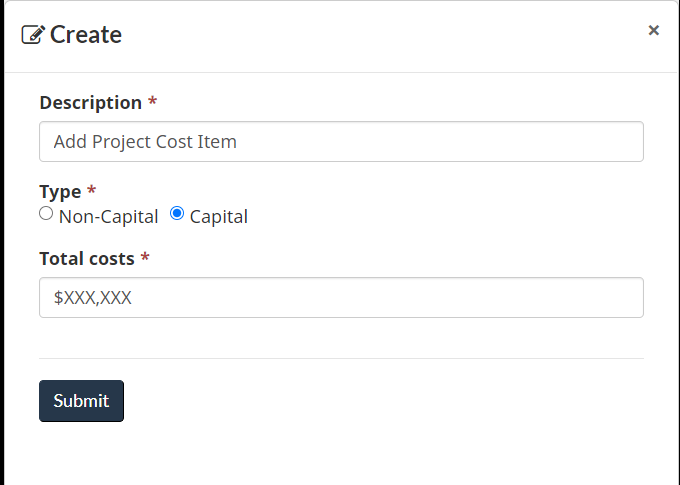
Cash flows
Fiscal Year (Ending March 31): Year 1
- Total Fiscal Expenditures
- Anticipated total project costs incurred in Year 1.
- RDA Funding
- The amount of RDA funding being requested to support Year 1 expenses.
- Non-RDA Funding
- Automatically generated: the expenditures not covered by RDA funding.
Fiscal Year (Ending March 31): Year 2
- Total Fiscal Expenditures
- Anticipated total project costs incurred in Year 2.
- RDA Funding
- The amount of RDA funding being requested to support Year 2 expenses.
- Non-RDA Funding
- Automatically generated: the expenditures not covered by RDA funding.
Fiscal Year (Ending March 31): Year 3
- Total Fiscal Expenditures
- Anticipated total project costs incurred in Year 3.
- RDA Funding
- The amount of RDA funding being requested to support Year 3 expenses.
- Non-RDA Funding
- Automatically generated: the expenditures not covered by RDA funding.
- To enter cash flow information, click the down arrow on the far right for the fiscal year you are interested in. Click the Edit option that appears. Note: the fiscal years shown below are for illustrative purposes only.

- Enter the “Expenditures” and “RDA Amount Requested” information and then hit Submit. You will still have the ability to edit the project cost item after hitting this Submit button. Note: the fiscal year shown below is for illustrative purposes only.
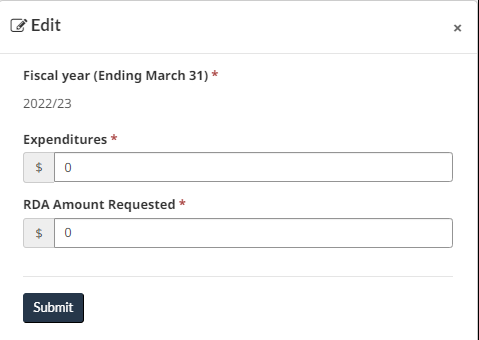
- RDA funding requested *
- This is the sum of the RDA Funding column in the Cash Flows section. It is automatically calculated.
- Total expenditures *
- This is the sum of the Total Fiscal Expenditures column in the Cash Flows section. It is automatically calculated.
Note: This total must equal the Total project costs from the Project Costs section above. - Total non-RDA funding *
- This is the sum of the Non-RDA Funding column in the Cash Flows section. It is automatically calculated.
Note: This total must equal the Amount provided by funding partners from the Funding Partners section below.
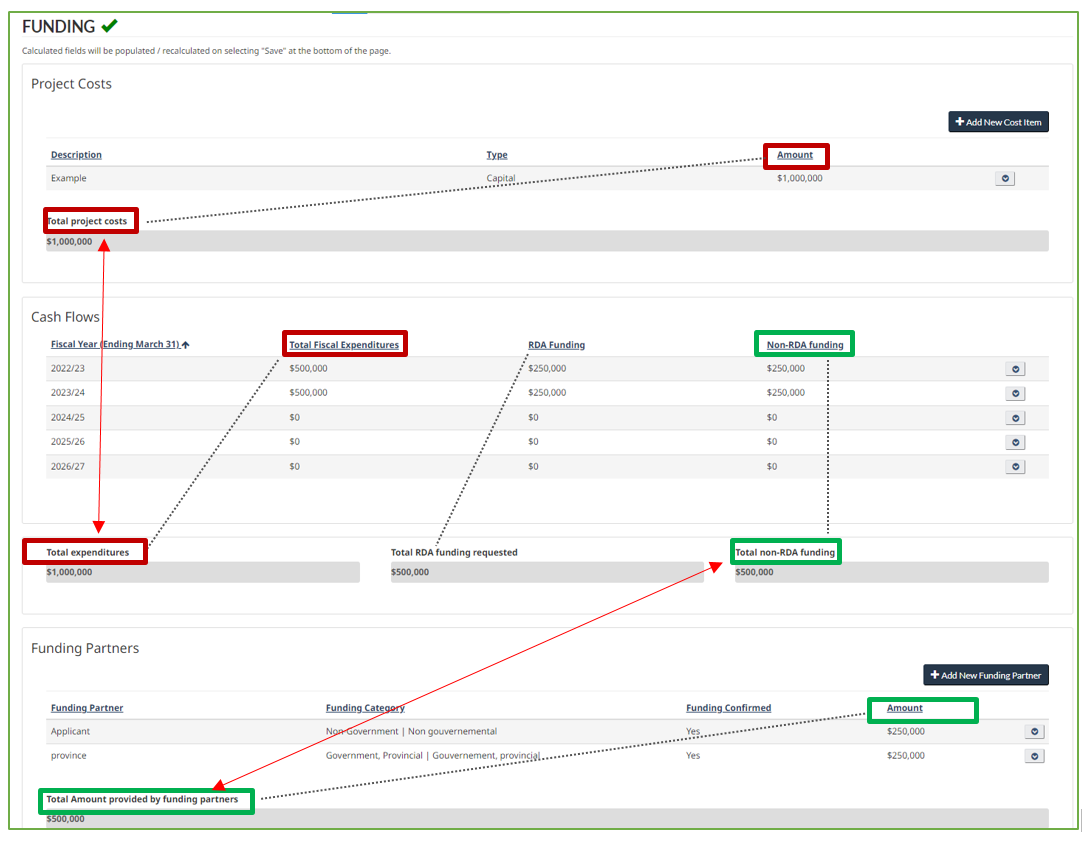
The solid arrows point to the fields that must balance and the dotted lines indicate what column is being summed to produce those totals. Note: the fiscal years shown above are for illustrative purposes only.
Funding partners
- Funding Partner
- Please note that the first entry in the list of funding partners is reserved for your own organization (the “Applicant”). Add other funding partners or contributors, if any, in subsequent rows.
Identify all potential project contributors that will provide funding as a monetary contribution or in-kind contribution.
Note: recipients must ensure all contributions (including in-kind contributions) are clearly verifiable. - Funding Category
- Select from the drop down menu the description that best reflects the funding source.
- Funding Confirmed
- Indicate if the funding has been confirmed.
In the case where your organization (Applicant) is a source of funding, indicate yes if you have cash on hand. - Amount
- The anticipated amount of funding this partner will provide.
- Amount provided by funding partners
- Automatically sums the funding amounts listed above.
Note: This total must equal the Total non-RDA funding from the Cash Flows section above.
- To add a funding partner, click on the
 button and the following window will appear for you to input the information. Click the Submit button once complete. You will still have the ability to edit the project cost item after hitting this Submit button.
button and the following window will appear for you to input the information. Click the Submit button once complete. You will still have the ability to edit the project cost item after hitting this Submit button.
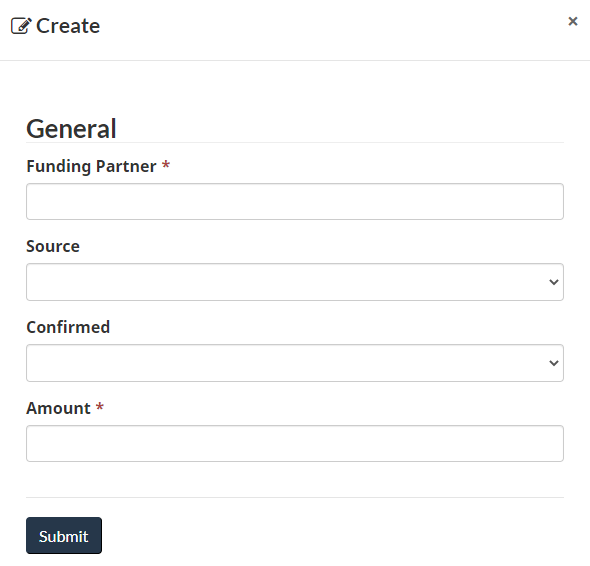
- To edit what your organization will be contributing towards this project, click the down arrow on the far right for the fiscal year you are interested in. Click the Edit option that appears and a similar pop-up window as shown above will appear.

- Briefly describe any partnerships (non-financial and financial) for this project (maximum of 1200 characters including spaces): *
- Describe your management team (including board or directors, advisors) and/or partnerships that would be important to the success of the proposed project.
Signing authority
Indicate here the individual within your organization who has signing power / the authority to enter into an agreement. This person may be different from the contact person.
- Title *
- Provide the contact person’s job title (e.g., President, Executive Director).
- Email address *
- The email at which the primary contact may be reached.
Diversity and inclusion
The Government of Canada is committed to diversity and inclusion so that all Canadians have the opportunity to participate in and contribute to the growth of the economy. Gender and diversity data collected may be used for research, statistics, program and policy evaluation, risk management, strategy development, reporting, and gender-based analysis (including GBA+). This information can help the Government of Canada monitor progress on inclusive access to federal support programs and services; to identify and remove barriers; and, to make changes to improve inclusive access. The Government of Canada understands that participation of underrepresented groups is an integral part of building strong and inclusive communities and economy.
No personal identifying information will be shared. Aggregate and anonymous data may be shared with other federal organizations and/or published for reporting and monitoring purposes.
- Is your organization majority (i.e. over 50%) owned or led by individuals who self identify as:
- Definition: majority owned or led is defined as individuals with long-term control and management of the organization and an active role in both strategic and day-to-day decision making.
If applicable, please indicate whether your organization is led or majority-owned by one or more of the listed groups. Note that this information may be used in the assessment process. Aggregate and anonymous data may be shared with other federal organizations, and/or published for reporting and monitoring purposes. If you do not know if a particular group is involved in the management team, or prefer not to answer, please select ‘prefer not to answer/do not know’ from the drop down box. - Will your project directly support any of the following diverse groups?
- This question is regarding the people that will benefit from this project. Will your project directly support any of the groups listed? If so, please answer ‘yes’. If you do not know if your project will directly support a particular group, or prefer not to answer, just leave the field blank. This information may be considered in assessing your project.
- If yes, please specify (maximum of 1,500 characters, including spaces)
- Provide an explanation.
Documents
Upload here the supporting documents to be provided with your EOI.
Upload the following mandatory documents:
- financial statements for the past 2 years, as well as interim financial statements for at least the last 6-month period;
- confirmation of other funding sources (e.g. bank statements, unused portion of lines of credit, official letters of intent, funding agreements, signed term sheets);
- other supporting documentation (e.g. business plan, pitch deck) detailing your organization (including management team, board of directors), and details about the proposed project.
Validation
For this step, any errors or omissions in the form will be brought to your attention, and you will be given the opportunity to review them, and make any necessary corrections.
Attestation
Before you can complete and submit your expression of interest, it is necessary in this final step for you to affirm that you are aware of certain statutory obligations, and that your organization meets the eligibility requirements for the RIE program. The attestation must be completed by a member of your organization with signing power/authority to enter into a legal agreement. For your reference, the complete text of this attestation is given below.
Please select “I agree” to affirm, and then submit using the “Submit” button.
On behalf of the Applicant Organization, I hereby acknowledge and agree that:
This expression of interest does not constitute a commitment from Prairies Economic Development Canada (PrairiesCan) for financial assistance.
Any person who has been lobbying on behalf of the Applicant Organization to obtain a contribution as a result of this expression of interest is registered pursuant to the Lobbying Act and was registered pursuant to that Act at the time the lobbying occurred.
The Applicant Organization is under no obligation or prohibition, nor is it subject to, or threatened by any actions, suits or proceedings, which could or would affect its ability to implement this proposed project.
The Applicant Organization has not, nor has any other person, corporation or organization, directly or indirectly paid or agreed to pay any person to solicit a contribution arising as a result of this expression of interest for a commission, contingency fee or any other consideration dependent on the execution of an Agreement or the payment of any contribution arising as a result of this expression of interest.
Prairies Economic Development Canada (PrairiesCan) and Pacific Economic Development Canada (PacifiCan) are government institutions as defined under the Access to Information (ATI) Act. Records in the custody and care of the institution are subject to disclosures under Part 1 and Part 2 of the ATI Act with limited exceptions and exclusions.
Personal information collected by PrairiesCan is collected in accordance with section 4 of the Privacy Act (R.S.C., 1985, c. P-21). This information will be used to determine eligibility, administer grants and contributions, and evaluate program effectiveness. Personal information collected is described in the Personal Information Bank entitled “Grants and Contributions”, number PrairiesCan-PPU-055. Questions regarding the collection and use of your personal information may be directed to the ATIP Coordinator, PrairiesCan, Canada Place, 1500-9700 Jasper Avenue NW, Edmonton, Alberta T5J 4H7, by telephone at 780-495-4164, or by email to atip-aiprp@prairiescan.gc.ca.
If you choose not to provide the personal information, your application may not be processed.
You have a right under section 12 of the Privacy Act to access to your personal information under the control of PrairiesCan as well as a right to request correction of personal information where there is an error or omission. You have the right to make a complaint to the Office of the Privacy Commissioner under section 29(1) of the Privacy Act regarding PrairiesCan’s collection, use, and disclosure of your personal information, processing of your request for correction of personal information or processing of your access to personal information request.
I authorize PrairiesCan, its officials, employees, agents and contractors to make credit checks and enquiries of such persons, firms, corporations, federal, provincial and municipal government departments/ agencies, and non-profit, economic development or other organizations as may be appropriate, and to collect and share information with them, as PrairiesCan deems necessary in order to assess this expression of interest, to administer and monitor the implementation of the subject project, and to evaluate the results of the project and related programs.